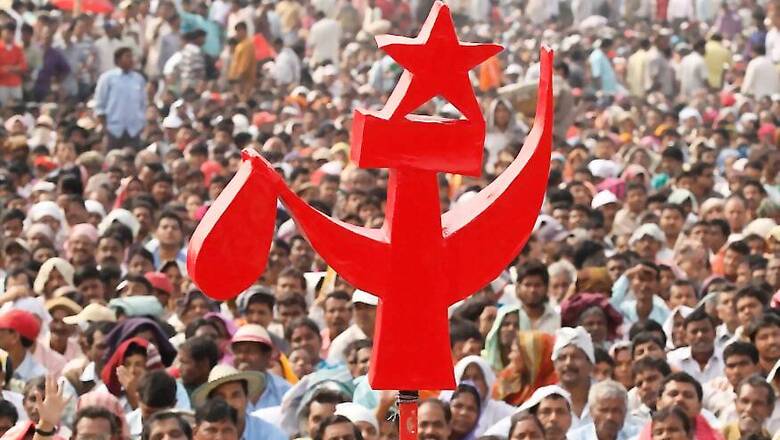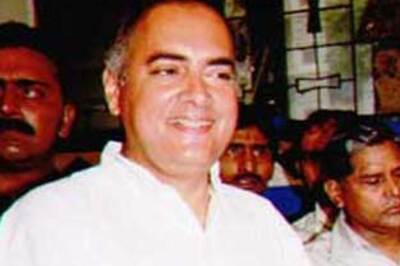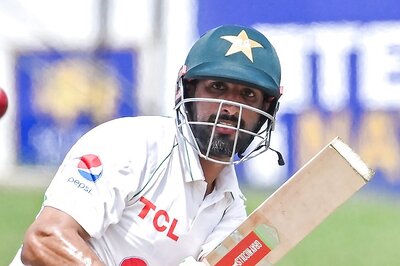
views
New Delhi: At 100 feet, the election symbol of the Communist Party of India (Marxist) – hammer, sickle and star – stands tall at the frontage of a brand-new red-stone building on an 1,800-square-metre plot in central Delhi. Below it is a single long mural, depicting the ideological beliefs of the party, as if announcing to the people what the Left stands for in India.
On October 2, the CPI(M) inaugurated the Surjeet Bhawan – a permanent party school for training cadres, in the memory of former general secretary and politburo member Harkishan Singh Surjeet.
Firmly marking its place in the skyline of the Delhi, the building on a road named after another communist leader, Indrajit Gupta, and across the road from the imposing Bharatiya Janata Party headquarters is testament to Surjeet’s steadfast opposition to the BJP and communalism and his legacy as kingmaker to a number of “secular” coalitions.
Those were the days when the Left Front – comprising the CPI(M), the Communist Party of India (CPI) and others – enjoyed considerable clout in making and breaking governments. Now, they have been reduced to single digits in Parliament, and have lost all their traditional bastions except Kerala and a few university campuses.
The striking mural on Surjeet Bhawan was commissioned to an artist from Nadia district in West Bengal – a historically Left-leaning state now ruled by the Trinamool Congress, with the BJP fast gaining ground. The artwork, sculpted on stone, was completed with close involvement of all party leaders.

“The mural has figures of Bhagat Singh, Rajguru and Sukhdev at the top. They are our source of inspiration and the symbol of supreme sacrifice. Below it, is the depiction of the composite culture of India – the different backgrounds and works we indulge in. Then, there is a figure of Surjeet. At the bottom, the working class population in India, who come from varied backgrounds, are portrayed as marching forward with the spirit of liberty,” said Jogender Sharma, in-charge of the Bhawan and a CPI(M) central committee member.
Sharma single-handedly oversaw the construction of the building, not far from the CPI(M) central committee office, ever since it was first conceived at the turn of the previous decade. Today, the state-of-the-art structure has a 466-seater auditorium, a 108-seater lecture hall, a conference room, housing area, office area and library.
And not just the mural. Everything outside the building also has a personal touch: perhaps, a defining characteristic of the Left’s socialist beliefs. The plants, especially curry leaves, within the premises were brought by party members from Kerala. The statue of Surjeet placed at the entrance is from Kolkata. The former general secretary’s iconic dark glasses that adorn the statue are from Punjab.
“I went to his family in Punjab and got them. We had to get it right. The party was honouring Surjeet for his contributions. And it was also the CPI(M) setting its foot in the capital,” Sharma said.
Deconstructing the Bhawan
The UPA-1 government in 2004 had come up with a national policy that all major political parties be allotted land for their offices. Parties were to be provided space based on their strength in Parliament. The CPI(M) was given an acre of land. But, it wasn’t until 2013 that it gained legal possession.
“The government couldn’t give us full possession of the land because of encroachment on it,” recalled the central committee member, adding, “Some people in powerful positions were indirectly owning the land. There was a school on it which they owned.”
The fight for full possession of the land went on for two and a half years. “Out of the total four plots, we were given three. Ultimately, we had to surrender the plot with the school,” Sharma said.
However, this was only the beginning of another four years of struggle to make space for themselves in the national capital. The construction of the Bhawan began in 2017 after facing many hurdles.
According to rules from an earlier version of the Delhi Master Plan 2021, the land allotted to the CPI(M) was meant for offices only. No residential accommodation could be created there. But, setting up a training school where CPI(M) cadres in groups of hundred or more could live and educate themselves was the sole motivation behind creating such a structure, party leaders say.
“The only way we could get past this hurdle was to get the Delhi Master Plan 2021 amended. We proposed an amendment to that. And that was passed in 2013. It was a long and tedious process,” Sharma said.
The party had acquired the land on paper. However, getting physical possession of it was most the difficult part because of encroachment on the land, added Sharma.
Four agencies were involved in the rehabilitation of the people: the union urban development ministry, the Municipal Corporation of Delhi, the Delhi Development Authority and the slum department. The CPI(M), Sharma said, was committed to adhering to the state policy on rehabilitation.
“We had fought with the VP Singh government to bring a policy on rehabilitation after eviction. To get the people an alternate space for living was the most difficult part. But, we had to follow our principles,” he emphasised.
Adding to the rehabilitation issues, Sharma said, were problems associated with getting the building plans approved. “Everything was under the control of the BJP government at the Centre. They placed hurdles for us in every step. They only couldn’t take back the land because the previous government allotted it to us.”
Reimagining the Left
According to party leaders and members of its wing, the Students’ Federation of India, the building was Surjeet’s dream. He was eager to have a permanent central school to emphasise the need for party education, culture, propaganda in vernacular language and connect with the people. It was only after his death in 2008 that land for the school was allotted.
A massive donation drive that the over 10 lakh party members undertook financed the entire project. In Kerala, for instance, cadres collected money in buckets. The state contributed Rs 9 crore in 48 hours.
That the Left has always had a passion for participatory politics is finely imprinted in the making of this state-of-the-art centre. However, Sitaram Yechury, general secretary of the CPI(M), told News18 that the Bhawan will play a key role in the reimagination of the Left by building stronger cadre and improving party membership.
“One thing that Comrade Surjeet always held was that every party member should be well-equipped in party ideology, and equipped also with changing circumstances. He used to emphasise that Marxism actually means concrete conditions and concrete analysis. Conditions (the present environment) have to be properly identified, understood and analysis has to follow that. And that is what this party school is supposed to impart,” he said.
“We will start the central school with proper syllabus very soon. Properly equipping our cadre is important to face the rising nationalism of the RSS and the BJP.”
A criticism that the Left often faces in the country is the age difference of the party leadership and the cadre. Yechury stressed that the purpose of the Bhawan is also to change this. “In a country with an average age of less than 40, a party whose leadership has an average age of 60 does not go well. This has to change. And we are changing this,” he said.
The CPI(M) general secretary told News18 that the party is in the process of changing age limits at various levels. The age criteria of new inductees in committees will also soon witness change. “Older people should not be made members of new committees,” he said.
The Surjeet Bhawan is set to be opened to public on March 23, 2020 – the martyrdom day of Bhagat Singh and also the adopted birthday of HKS Surjeet. Having been associated with this project for years now, Sharma has a certain sentiment attached to the structure.
As a young comrade joining in 1969, the central committee member’s decades-long connection perhaps culminates in this reimagination of the CPI(M). He said the party views the Bhawan as a “cultural hub for secular and democratic groups” and not intended for business.
“This is the nerve centre of politics. There is the BJP office, a Congress Bhawan is coming, there are smaller party offices of the TMC, RJD, etc. There are trade union centres here too. In the middle of all this, the Left has made space for itself with a school that will create future leaders. We are finally here,” he added.



















Comments
0 comment